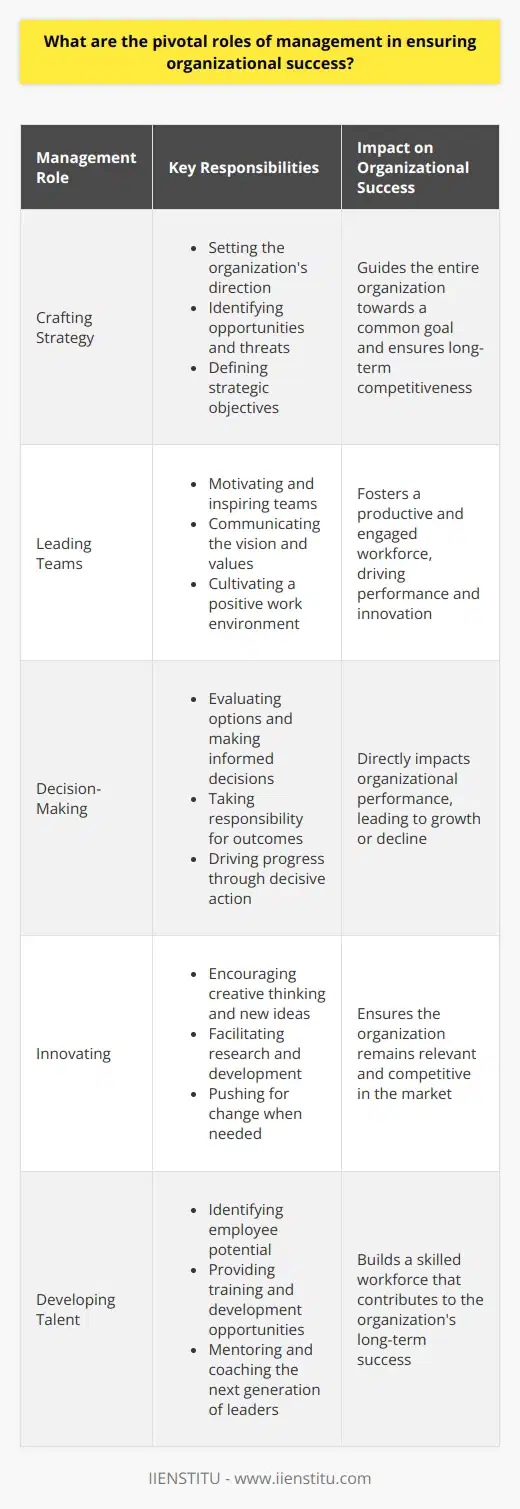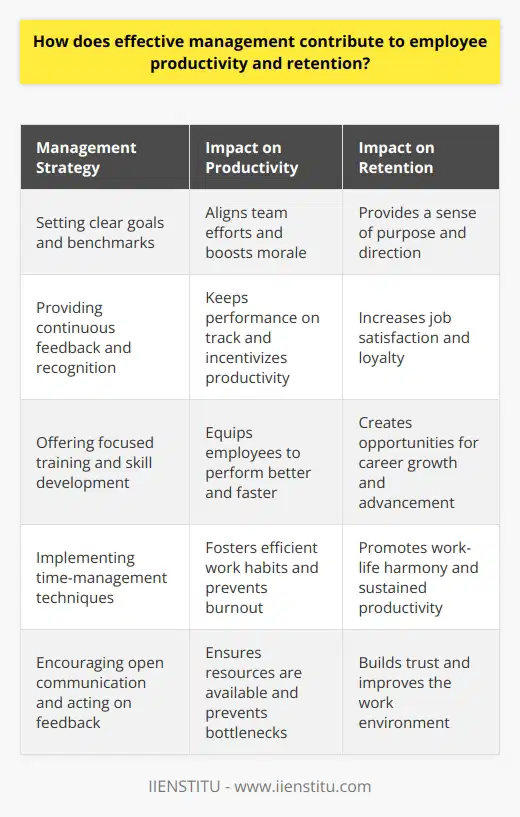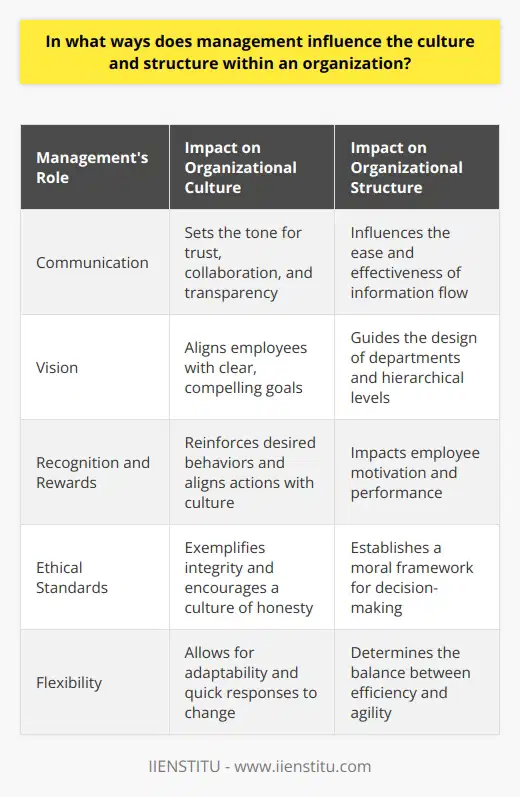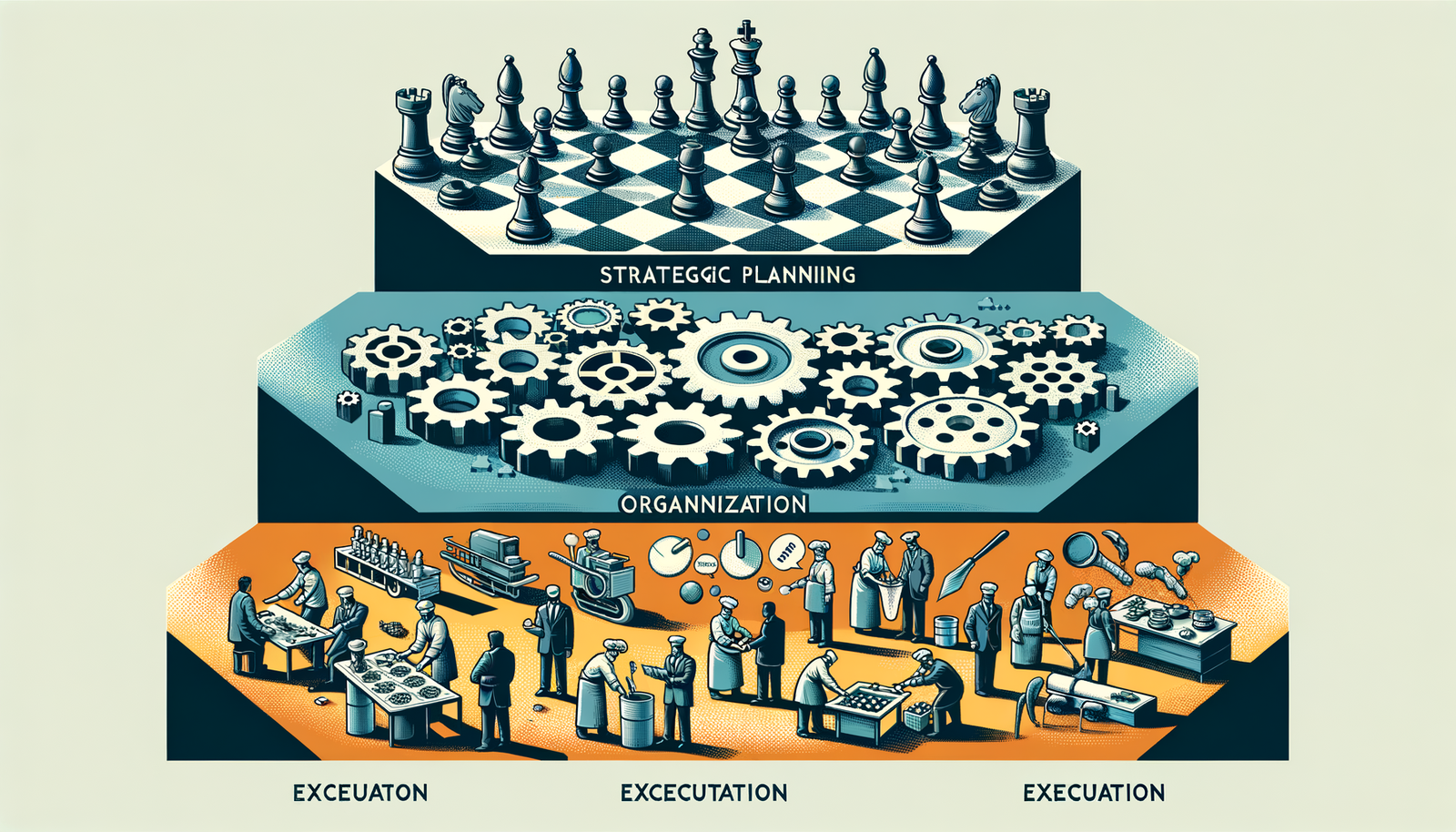
In an ever-evolving business landscape, the importance of management in organizational success cannot be overstated. The synergy between visionary leadership and robust management strategies forms the bedrock upon which corporate triumphs are built. This article is a scholarly endeavor aimed at unraveling the intricate layers of management's contribution to achieving the pinnacle of an organization's potential. Through an in-depth exploration of key concepts and strategies, we shall outline the indispensable elements that translate into an enterprise's accomplishments. By integrating lessons from this analysis, managers can pursue excellence in their respective domains, thereby actualizing the aspirational goal of sustainable organizational success.
Understanding the Role of Management in Organizational Success
To commence, it is crucial to understand what management entails within a business context. At its core, management is the art of guiding an organization towards realizing its objectives through the efficient and effective utilization of resources. It involves a series of actions and decisions that form the framework necessary for harmony and progression within a company. These actions are predicated on strategies for sustainable growth that are both proactive and responsive, considering the internal and external factors that influence company operations.
As Peter Drucker, the renowned management consultant, once said, "Management is doing things right; leadership is doing the right things" (Drucker, 2006, p. 22). This quote encapsulates the essence of management's role in steering an organization towards success.
The Multifaceted Functions of Managers
The functions of management are multifaceted and include planning, leading, organizing, and controlling. Planning encompasses forecasting future needs and setting goals to chart the course for the organization. Leading involves motivating and directing teams to achieve the set objectives. Organizing requires arranging resources, including human capital and materials, in the most efficient manner. Controlling, the final function, ensures that the company's activities align with the planned objectives, making adjustments as necessary. These functions form a continuous cycle that propels a company toward its aims.
According to Henry Mintzberg's seminal work, "The Nature of Managerial Work," managers fulfill ten distinct roles, categorized into interpersonal, informational, and decisional roles (Mintzberg, 1973, p. 54-99). These roles highlight the complex and varied nature of management responsibilities.
Visionary Leadership and Decision-Making
At the helm of management practices lies the role of visionary leadership in business success. It is leadership that crafts long-term goals and policies that serve as the organization's roadmap. Through decisive and forward-thinking decision-making, leaders have the profound capacity to influence the strategic direction of an organization. The ability to anticipate market trends, innovate, and remain flexible in policy formulation distinguishes exemplary leaders who navigate their companies to enduring success.
Jim Collins, in his influential book "Good to Great," emphasizes the importance of Level 5 Leadership, which combines humility and fierce resolve (Collins, 2001, p. 17-40). This type of leadership is instrumental in driving organizations from mediocrity to greatness.
Key Management Strategies for Nurturing Organizational Success
For an organization to thrive, management must meticulously cultivate effective management strategies that champion its mission. These strategies serve as the compass by which all company endeavors are guided, ensuring a cohesive approach towards goal attainment. Selecting the right strategies and applying them effectively can be a determining factor in the success trajectory of an organization.
Fostering a Productive Work Environment
Creating a work environment that fosters a productive work environment is essential. Management can achieve this by shaping a culture of support and motivation where individuals are valued and recognized for their contributions. Examples abound of companies that have embraced management practices resulting in a robust corporate culture; these include:
1- Regular feedback and performance reviews
2- Employee recognition programs
3- Opportunities for professional development and growth
4- Work-life balance initiatives
5- Collaborative and inclusive team dynamics
Such initiatives not only enhance employee satisfaction but also boost overall company performance.
In his book "Drive: The Surprising Truth About What Motivates Us," Daniel Pink argues that intrinsic motivation, driven by autonomy, mastery, and purpose, is key to employee engagement and productivity (Pink, 2009, p. 85-146).
Implementing Robust Communication Channels
Transparent and effective communication underpins successful management. The implementation of robust communication channels enables clarity of expectations, fosters teamwork, and solidifies the bonds between different tiers within an organization.
Featuring case studies, such as those presented in "The Power of Communication: Skills to Build Trust, Inspire Loyalty, and Lead Effectively" by Helio Fred Garcia, it is evident that companies with open channels of communication weather storms more effectively and showcase agility in the face of adversity (Garcia, 2012, p. 103-128). Effective communication, therefore, is not simply a management tool; it's an integral part of the organization's lifeline.
Effective Management Practices for Sustained Company Growth
To secure sustained growth, management practices must be progressive and dynamic, continually aligning with the company's evolving needs. Effective management is about more than achieving short-term wins; it is about instilling a culture of continuous improvement and evolution within the organization.
Encouraging Innovation and Adaptability
A key function of management involves cultivating a workplace where innovation and adaptability are the norm. Managers can spur innovation by encouraging adaptability in business management, embracing new technologies, and remaining receptive to change. A company culture that celebrates novel ideas and swift adaptability to market shifts is better poised to stay relevant and competitive.
In "The Innovator's Dilemma," Clayton Christensen explores the concept of disruptive innovation and the importance of adaptability for organizational success (Christensen, 1997, p. 3-32). Companies that fail to adapt to changing market conditions risk being overtaken by more agile competitors.
Talent Management and Employee Development
An astute approach to talent management and employee development best practices is the hallmark of effective management. Recognizing that employees are a company's greatest asset involves not only attracting the best talents but also investing in their development and retention. This includes offering:
Mentorship programs
Leadership development initiatives
Skills training workshops
Educational assistance and tuition reimbursement
Career advancement opportunities
Companies that excel in talent management boast higher employee engagement and productivity, contributing significantly to organizational success.
In "The War for Talent," Ed Michaels, Helen Handfield-Jones, and Beth Axelrod emphasize the critical role of talent management in driving business success (Michaels, Handfield-Jones, & Axelrod, 2001, p. 1-20). They argue that companies that prioritize talent management gain a significant competitive advantage.
Assessing the Impact of Leadership in Management Success
The influence of leadership in management cannot be overstated. Business leadership frames the management ethos and therefore directly impacts the success of management practices. The best leaders not only communicate a clear vision but also foster a company culture of excellence and integrity.
Ethical Leadership and Corporate Responsibility
The benefits of ethical leadership in management and a commitment to corporate social responsibility are pillars of successful management. Embedding ethical considerations into leadership practices propels the organization toward not only financial success but also societal respect and loyalty. The interplay between ethical leadership and management is a core component of enduring organizational success.
In "Authentic Leadership: Rediscovering the Secrets to Creating Lasting Value," Bill George argues that ethical leadership is essential for building trust, inspiring followers, and achieving long-term success (George, 2003, p. 9-33).
The Balance Between Autonomy and Guidance
Effective management strikes a delicate balance between balancing autonomy and guidance in leadership. By empowering team members with the liberty to make decisions and take ownership, while still providing the necessary direction and support, managers can foster a cooperative and innovative environment. This balance is critical to nurturing an empowered workforce that contributes to a company's success without micromanagement stifling creativity.
In "Drive," Daniel Pink discusses the importance of autonomy in fostering motivation and engagement (Pink, 2009, p. 85-106). He argues that providing employees with autonomy leads to increased job satisfaction and performance.
Innovative Approaches to Company Management
In today's fast-paced business environment, innovative approaches to company management are essential for staying ahead of the curve. Managers must continually seek out new ideas, technologies, and methodologies to optimize operations and drive growth. Some innovative approaches include:
1- Agile project management
2- Design thinking
3- Data-driven decision-making
4- Flat organizational structures
5- Remote work and flexible work arrangements
By embracing these innovative approaches, companies can foster a culture of continuous improvement and adaptability, positioning themselves for long-term success.
In "The Lean Startup," Eric Ries introduces the concept of validated learning and the build-measure-learn feedback loop, which enables companies to rapidly test and refine their strategies (Ries, 2011, p. 75-102). This innovative approach to management has been widely adopted by startups and established companies alike.
The Impact of Corporate Culture on Organizational Performance
The impact of corporate culture on organizational performance cannot be understated. A strong, positive corporate culture can be a powerful driver of employee engagement, productivity, and loyalty. Conversely, a toxic or misaligned culture can undermine even the most well-crafted management strategies.
In "Good to Great," Jim Collins emphasizes the importance of a strong corporate culture in achieving and sustaining success (Collins, 2001, p. 176-187). He argues that companies with a culture of discipline, combined with an ethic of entrepreneurship, are more likely to achieve greatness.
Building a Culture of Continuous Improvement
One of the key elements of a high-performing corporate culture is a focus on continuous improvement in organizations. By fostering a culture where employees are encouraged to identify opportunities for improvement, experiment with new ideas, and learn from failures, companies can drive innovation and stay ahead of the competition.
In "The Toyota Way," Jeffrey Liker explores the principles and practices that have made Toyota one of the most successful and admired companies in the world (Liker, 2004, p. 85-168). Central to Toyota's success is a culture of continuous improvement, or kaizen, which empowers employees at all levels to contribute to the company's growth and development.
Conclusion
The tenets of effective management are the cornerstone of organizational success. This article has endeavored to outline the critical role of management and the key strategies that underpin a company's achievements. With continued focus on fostering a productive work environment, ensuring robust communication, encouraging innovation, and maintaining a balance between autonomy and guidance, organizations can navigate the pathway to prosperity. The emphatic relationship between business leadership and comprehensive management strategies forms the fulcrum for cultivating flourishing enterprises.
A call to action for the readers would be to introspect and amalgamate the key management strategies, practices, and leadership qualities discussed herein to forge ahead in their pursuit of organizational success. A renewed commitment to these principles is not merely a managerial objective; it is a blueprint for corporate excellence.
References
Christensen, C. M. (1997). The innovator's dilemma: When new technologies cause great firms to fail. Harvard Business School Press.
Collins, J. C. (2001). Good to great: Why some companies make the leap... and others don't. HarperBusiness.
Drucker, P. F. (2006). The practice of management. HarperBusiness.
Garcia, H. F. (2012). The power of communication: Skills to build trust, inspire loyalty, and lead effectively. FT Press.
George, B. (2003). Authentic leadership: Rediscovering the secrets to creating lasting value. Jossey-Bass.
Liker, J. K. (2004). The Toyota way: 14 management principles from the world's greatest manufacturer. McGraw-Hill.
Michaels, E., Handfield-Jones, H., & Axelrod, B. (2001). The war for talent. Harvard Business School Press.
Mintzberg, H. (1973). The nature of managerial work. Harper & Row.
Pink, D. H. (2009). Drive: The surprising truth about what motivates us. Riverhead Books.
Ries, E. (2011). The lean startup: How today's entrepreneurs use continuous innovation to create radically successful businesses. Crown Business.
Frequently Asked Questions
What are the pivotal roles of management in ensuring organizational success?
The Essence of Management
Management stands at the core of any organization's success. Leaders provide vision. They align resources. Effective management ensures organizational agility. They foster innovation. Managers must handle complex duties. They oversee operations, guide employees, and shape strategies. Good management involves various critical roles. Let's explore these pivotal roles in detail.
Crafting Strategy
Managers craft strategy. They set the organization's direction. Strategy development requires foresight. It involves understanding market trends. Managers identify opportunities. They assess threats. Setting clear goals is crucial. Managers define strategic objectives. These targets guide the entire organization.
Organizing Resources
Resource organization is vital. Managers allocate resources wisely. They must match tasks with suitable personnel. Efficient resource use is essential. It ensures maximum productivity. Managers also oversee financial assets. They ensure the financial health of the organization.
Leading Teams
Effective leadership inspires. Managers lead by example. They motivate their teams. Strong leadership breeds a productive workforce. Managers communicate the vision. They transmit organizational values. They encourage teamwork and collaboration. Managers solve interpersonal conflicts. They cultivate a positive working environment.
Decision-Making
Decisive action drives progress. Managers make key decisions daily. They evaluate different options. Quick, informed decisions are necessary. Managers take responsibility for the outcomes. Strong decision-making impacts organizational performance. It can lead to growth or decline.
Controlling Quality
Quality control safeguards standards. Managers enforce quality measures. They establish performance benchmarks. Managers monitor operational processes. They ensure adherence to quality standards. Continuous improvement is their mantra. They initiate corrective actions when necessary. High quality means customer satisfaction.
Innovating
Innovation ensures relevancy. Managers encourage creative thinking. They support new ideas. Innovation drives competitive advantage. Managers facilitate research and development. They push for change when needed. Stagnation is not an option.
Communicating
Clear communication is imperative. Managers disseminate information effectively. They ensure messages are understood. Communication happens both ways. Managers listen to feedback. They address concerns and queries. Good communication builds trust.
Developing Talent
Talent development is strategic. Managers identify employee potential. They provide training and development. Career growth opportunities are essential. Managers mentor and coach. They prepare the next generation of leaders. Skilled people contribute to success.
Managing Change
Change management is crucial. Organizations must adapt. Managers lead change initiatives. They assist employees through transitions. Managers minimize resistance to change. They ensure the organization remains resilient.
Monitoring Performance
Performance monitoring drives results. Managers review progress towards goals. They use performance metrics. Managers provide constructive feedback. They recognize achievements. They push for greater efficiency. Performance reviews are regular. They allow timely adjustments.
Risk Management
Risk anticipation mitigates threats. Managers identify potential risks. They analyze probabilities and impacts. Risk management strategies are essential. Managers create contingency plans. They prepare for uncertainties. Risk management protects the organization.
Ensuring Compliance
Compliance can't be overlooked. Managers enforce legal regulations. They adhere to industry standards. Compliance protects the organization from liabilities. Managers conduct regular audits. These ensure protocols are followed.
Fostering Corporate Culture
Corporate culture shapes behavior. Managers promote an ethical culture. They instill values within teams. Strong culture unites employees. It represents the company's identity. Managers guard the organization's reputation.
Through these vital roles, managers form the bedrock of an organization. They influence success at every level. Staying adaptive and proactive is their mission. Embracing these roles ensures sustained organizational excellence.

How does effective management contribute to employee productivity and retention?
Effective Management and Its Impact
Effective management holds the key to unlocking workforce potential. Managers guide teams toward goals. Their strategies shape workplace culture. This impacts employee productivity and retention significantly.
Driving Productivity through Effective Management
Managers define productivity benchmarks. They create a clear roadmap for employees. Clear goals align team efforts. By setting realistic targets, managers boost morale. Continuous feedback keeps performance on track. Recognition and rewards further incentivize productivity.
Focused training equips employees with necessary skills. Skillful workers perform better and faster. Managers tailor training to individual and team needs. They ensure resources are available for tasks. This prevents bottlenecks and downtime.
Time-management techniques foster efficient work habits. Managers prevent burnout through workload balance. They promote work-life harmony, crucial for sustained productivity.
Enhancing Retention with Good Management
Retention reflects workplace satisfaction. Managers play a central role in employee engagement. Open communication builds trust. It involves listening and responding to feedback. Managers act on concerns, improving the work environment.
Career development opportunities retain ambitious employees. Managers identify and nurture potential. They offer mentorship and advancement paths. Growth possibilities keep employees motivated and loyal.
Recognition matters. Managers who appreciate effort cultivate loyalty. Simple thanks can greatly increase job satisfaction. Personal achievements tied to company success matter. Employees feel part of something bigger. They stay when they see their contributions matter.
Effective management transforms workplaces. It does more than improve the bottom line. It creates an environment where employees thrive. Through strategic goal-setting, tailored training, preventative burnout measures, and responsive leadership, effective management powers both productivity and retention. Commitment from management leads to commitment from employees. A virtuous cycle ensues, benefiting all stakeholders.

In what ways does management influence the culture and structure within an organization?
Management's Role in Shaping Organizational Culture
Management holds a pivotal role in defining an organization's culture. Consider culture as a living, breathing entity. It reflects shared values, beliefs, and norms. These elements stem from the top. Managers model behaviors. Staff emulate these actions. Leadership decisions echo through daily practices. Over time, they engrain become the norm.
Leadership's Influence on Culture
Communication is key. It sets the tone. It involves dialogue, transparency, and feedback. Managers who communicate openly foster trust. They inspire collaboration.
Vision drives the organization. Management articulates this vision. Employees align with clear, compelling goals.
Recognition and rewards play a part. They reinforce desired behaviors. Management must incentivize effectively. This aligns actions with the culture.
Ethical standards set a moral baseline. Leaders exemplify integrity. Employees follow suit, encouraging a culture of honesty.
Management's Impact on Organizational Structure
Organizational structure shapes how work happens. Management designs this structure.
Hierarchical levels matter. Fewer levels can mean easier communication. More levels may create clear authority lines.
Department organization reflects priorities. Functional structures focus on expertise. Divisional structures stress product lines.
Centralization versus decentralization reflects decision-making. Centralized structures consolidate control. Decentralized structures empower employees.
Flexibility is a design choice. It allows quick responses. Rigid structures optimize for efficiency.
In conclusion, management profoundly influences culture and structure. Leaders must therefore act consciously. Their choices affect the organization's success. The best managers understand this responsibility. They craft cultures and structures that achieve strategic goals.



